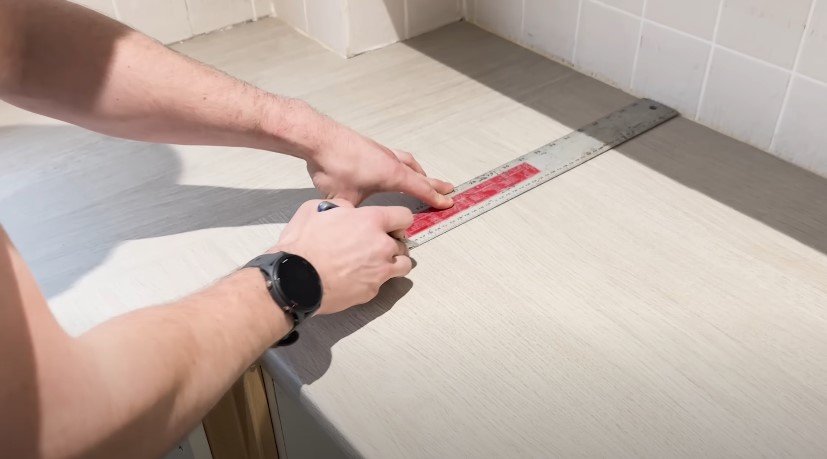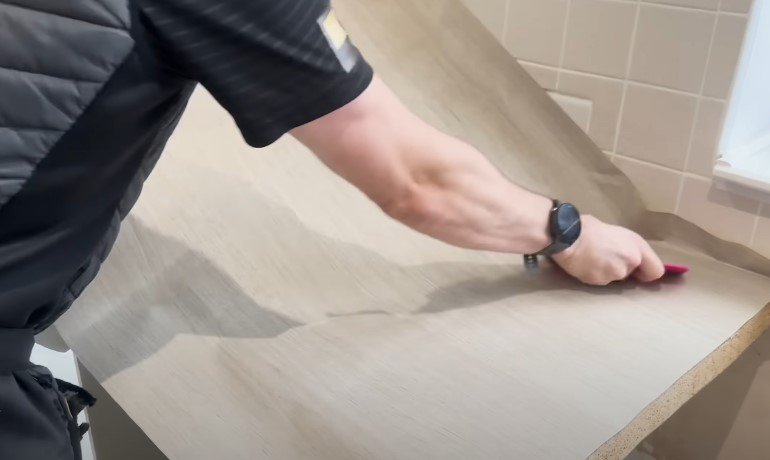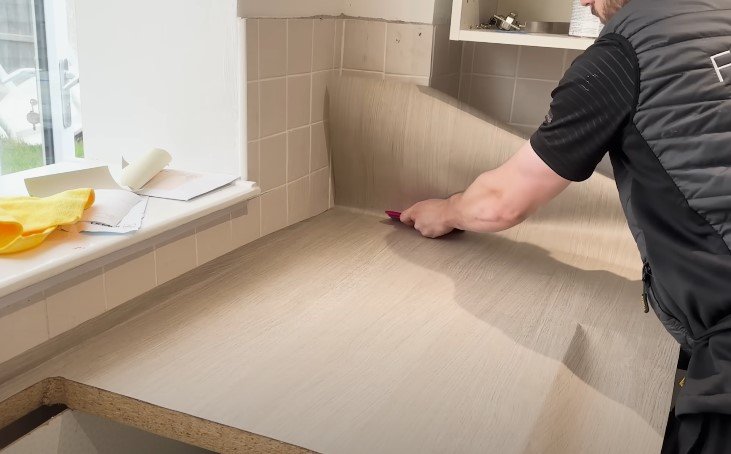Tired of an old kitchen but don’t want to spend a fortune? Many homeowners feel the same, caught between expensive renovations and living with worn-out cabinets. That’s where kitchen wrapping comes in. It’s a clever, budget-friendly way to refresh a kitchen without tearing it apart. It raises the question: Is kitchen wrapping worth it? Spoiler—yes, it is. This guide explores how kitchen wrapping works, how long it lasts, and whether it’s the right choice for a cost-effective makeover. Let’s dive in and see how this simple solution can give any kitchen the fresh look it deserves.
What Is Kitchen Wrapping? (And Why It’s Gaining Popularity)
Ever heard of kitchen wrapping and wondered what the buzz is about? It’s like giving the kitchen a brand-new outfit—sleek, stylish, and far more affordable than a full renovation. Instead of removing old cabinets or dealing with messy paint jobs, a vinyl kitchen wrap film is applied directly over cabinets, doors, or drawers. It sticks smoothly, provides a fresh finish, and can completely transform the look and feel of a space.
Many homeowners are surprised the first time they see a vinyl-wrapped cabinet up close. The finish can mimic high-end materials—like matte, gloss, wood grain, or marble—and the transformation often takes just a day. There’s no dust, no paint smell, and no construction chaos. Plus, kitchen wrapping works even on older or laminate surfaces, making it a versatile option for nearly any kitchen.
So, can kitchen cabinets be wrapped instead of replaced? Absolutely—and it’s often much easier (and more cost-effective) than most people think.

Benefits of Wrapping Your Kitchen
Wrapping a kitchen is a smart, stress-free way to refresh the space without the hassle of a full renovation. It’s quick, clean, and significantly more affordable than replacing cabinetry, making it ideal for both small and large kitchens.
The biggest advantage? Cost savings. There’s no need to invest in brand-new cabinets. A simple vinyl wrap can give existing units a like-new appearance, instantly updating the entire room with a sleek, modern finish.
It also keeps the mess to a minimum. There’s no dust, no noisy equipment, and no harsh smells. Most vinyl wraps can be installed in just one day, minimizing downtime and disruption to daily routines.
The design possibilities are another major plus. From glossy white and matte black to wood textures and even realistic marble effects, there’s a finish to suit any taste. Some vinyl wraps are so realistic, they rival high-end materials at a fraction of the price.
For renters, vinyl wrapping is a game-changer. Since it doesn’t alter the underlying structure, it’s a reversible upgrade that won’t violate lease agreements. When tastes or trends change, the wrap can simply be swapped out.
So, is kitchen wrapping worth it? For those seeking a fast, affordable, and stylish kitchen transformation, the answer is a definite yes.
How to Wrap Kitchen Cabinets and Cupboards
Wondering how to wrap kitchen cabinets or cupboards? It’s actually much easier than it sounds. No professional skills required—just a bit of patience and the right tools. Many homeowners have tackled it over a weekend and been amazed at the transformation. Kitchen wrapping offers a cost-effective and mess-free alternative to a full renovation.
Step 1: Gather the Tools
To start, one will need a few basic supplies: a heat gun or hairdryer, a utility knife, a squeegee, and the vinyl wrap of choice. A measuring tape and a good cleaning spray are also helpful. A popular option is a matte wood grain vinyl wrap, which looks convincingly like real wood and adds warmth and character.
Step 2: Prepare the Surface
Clean all cabinet surfaces thoroughly—grease and grime will prevent the vinyl from sticking. It’s best to remove handles and hinges for a smoother finish and easier application.
Step 3: Apply the Wrap
Measure each door or panel, then cut the vinyl slightly larger than the surface. Slowly peel the backing and apply the wrap while smoothing it down with a squeegee. For corners and edges, a heat gun softens the vinyl, allowing it to bend and stick neatly.
Step 4: Trim and Reassemble
Once applied, trim the excess vinyl using a utility knife for clean edges. Then reattach any handles or hardware. In just one afternoon, it’s possible to give an entire kitchen a fresh, new look—no dust, no fumes, and minimal downtime.
Still wondering, “Can you vinyl wrap kitchen cabinets and achieve a great finish?” Absolutely. With the right materials and care, even beginners can pull off a stunning DIY makeover.
Can You Wrap All Types of Kitchen Units?
A common question is whether vinyl wrapping works on all types of cabinets. The good news? In most cases, yes. Vinyl wrap adheres well to common materials like MDF, laminate, and wood, making it a versatile solution.
What Works Well
Most modern kitchens use MDF or laminate cabinets—perfect surfaces for wrapping. As long as the cabinet faces are smooth, clean, and not greasy, the vinyl will stick well and last. Even older wooden cabinets can be wrapped, provided they’re not flaking or heavily damaged.
What to Watch For
Chipped or peeling surfaces need light sanding before wrapping. In high-heat zones—like near ovens or kettles—edges may lift over time unless heat-resistant vinyl is used. In humid areas, sealing corners properly helps prevent moisture damage and keeps the wrap secure.
It’s Not Just for Cabinets
Vinyl wrapping isn’t limited to cabinet doors. It also works on drawers, side panels, plinths, and even countertops (with care). The material’s flexibility allows it to mold around edges, providing a seamless finish that rivals custom cabinetry.
So, can you vinyl wrap kitchen cabinets that aren’t perfect? Yes—with a little prep work. For most standard units, wrapping is a simple, effective upgrade that brings stunning results.

How Long Does Kitchen Wrapping Last?
One of the most common concerns: “How long does kitchen wrapping last?”
On average, high-quality vinyl wraps last between 5 to 10 years, depending on usage, surface prep, and environmental conditions.
Longevity Depends on Preparation
Proper surface cleaning is crucial for adhesion. Skipping this step or using low-grade vinyl can lead to peeling within a year. However, with good prep and a durable wrap, the finish can stay pristine for many years.
Factors That Affect Durability
- Heat and Moisture: Areas near stoves, kettles, or dishwashers may experience edge lifting. Heat-resistant wraps can prevent this.
- Cleaning Habits: Gentle cleaning with a soft cloth (no harsh chemicals) helps extend lifespan.
- Damage Repair: If a panel gets scratched, it’s easy to rewrap just that piece—no need to redo the entire kitchen.
In the UAE or similar climates, installers often recommend weather-safe vinyl made to withstand high heat and humidity. Ask about kitchen wrapping Dubai cost options that include these more durable films.
So, is kitchen wrapping worth it if it won’t last forever? Absolutely. Even five years of a modern, upgraded look, at a fraction of the renovation cost, is a great return. And with proper care, it can easily last a decade.
Kitchen Wrapping in Dubai: What Does It Cost?
For anyone considering kitchen wrapping in Dubai, one of the first questions is usually, “What’s it going to cost?” Understandably, homeowners want a budget-friendly option without compromising on quality, and that’s where kitchen wrapping really shines.
In general, kitchen wrapping in Dubai costs between AED 800 and AED 3,000. The final price depends on several factors, including the size of the kitchen, type of vinyl wrap, and whether the job is done DIY or by a professional installer.
- Smaller kitchens with basic vinyl finishes typically fall on the lower end of the range.
- Larger kitchens or those opting for glossy, marble, or textured finishes will see higher costs.
A popular choice among homeowners is the matte wood grain vinyl, which gives a high-end look without the high-end price tag. The wrapping process often takes just a single day and avoids the mess, noise, and smell associated with traditional renovations.
Quality Makes a Difference
Not all wraps are created equal. Cheaper films may look good initially, but can start lifting, especially near heat sources or in humid areas. For Dubai’s climate, heat-resistant vinyl wraps are a smart choice, providing durability against temperature fluctuations and moisture.
Choosing the Right Installer
Many Dubai wrapping services offer free consultations and samples, allowing customers to see and feel the vinyl in their actual kitchen lighting. It’s important to ensure that the installer follows proper prep steps: deep cleaning, smoothing, and edge sealing. A quality application starts with a clean surface and attention to detail.
Whether updating just a few cabinet doors or refreshing an entire kitchen, vinyl wrapping offers a cost-effective, quick solution that doesn’t require structural changes. For those researching kitchen wrapping Dubai cost, the takeaway is simple: there’s an option for every budget and style.
Is Kitchen Wrapping Worth It?
So, is kitchen wrapping worth the investment? The answer is a resounding yes.
Many homeowners are initially skeptical. Can something this simple really transform a kitchen? But once they see the results—modern finishes, fresh looks, and no demolition—it becomes clear why kitchen wrapping is growing in popularity.
Vinyl wrapping allows anyone to update their kitchen cabinets without replacing them. The process is clean, fast, and surprisingly easy. Some DIY enthusiasts have even learned how to wrap kitchen cabinets by following online tutorials and completed entire projects over a weekend.
Why Homeowners Love It:
- Variety of Finishes: From glossy white and matte black to textured wood and faux marble, there’s a style to match every taste.
- Affordability: Compared to a full renovation, kitchen cabinet wraps cost significantly less.
- Longevity: When properly applied and maintained, vinyl wraps can last 5 to 10 years.
- Flexibility: If a cabinet door gets scratched or damaged, it’s easy to rewrap just that section.
- Ideal for Renters: No structural changes required, making it a reversible option for rented properties.
In warm climates like the UAE, using heat-resistant kitchen cabinet wraps ensures durability in high-moisture or heat-prone areas. Gentle cleaning—without harsh chemicals—can keep the wrap looking fresh for years.
Kitchen wrapping isn’t just a trend; it’s a practical design hack that delivers real results. For anyone seeking a budget-friendly kitchen makeover without the mess, stress, or high costs, vinyl wrapping is a smart solution.

FAQs About Kitchen Wrapping
Q1: Can you vinyl wrap kitchen cabinets yourself?
Yes, you can vinyl wrap kitchen cabinets yourself. It’s an easy DIY project with basic tools like a knife, squeegee, and heat gun.
Q2: What happens if the kitchen wrap gets damaged?
If the vinyl wrap gets scratched or damaged, you can replace only that section without redoing the whole kitchen.
Q3: Can you remove the vinyl wrap later?
Yes, vinyl wrap is removable. Use heat to loosen the adhesive and peel it off gently without damaging the cabinets.
Q4: Will wrapping work around sinks and corners?
Yes, kitchen wrap can fit around sinks and corners. Use heat to soften the vinyl and press it into place for a neat finish.
Q5: How long does kitchen wrapping last?
Kitchen wrapping lasts 5 to 10 years with proper care. Clean it gently and avoid high heat or harsh cleaning sprays.
Final Thoughts
Still wondering if kitchen wrapping is worth it? It absolutely is. Instead of costly renovations, wrapping offers a fast, clean, and affordable way to refresh your kitchen. No noise, no mess—just a stylish new look in a day.
Whether you’re renting or just need a quick upgrade, Fit Wrap provides professional kitchen wrapping services in Dubai that deliver stunning results. With proper care, wraps can last 5–10 years, and if one panel gets damaged, it’s easy to fix.
Want to try it? Start small or book a free consultation with Fit Wrap. It’s budget-friendly, stylish, and the easiest way to fall in love with your kitchen again.

